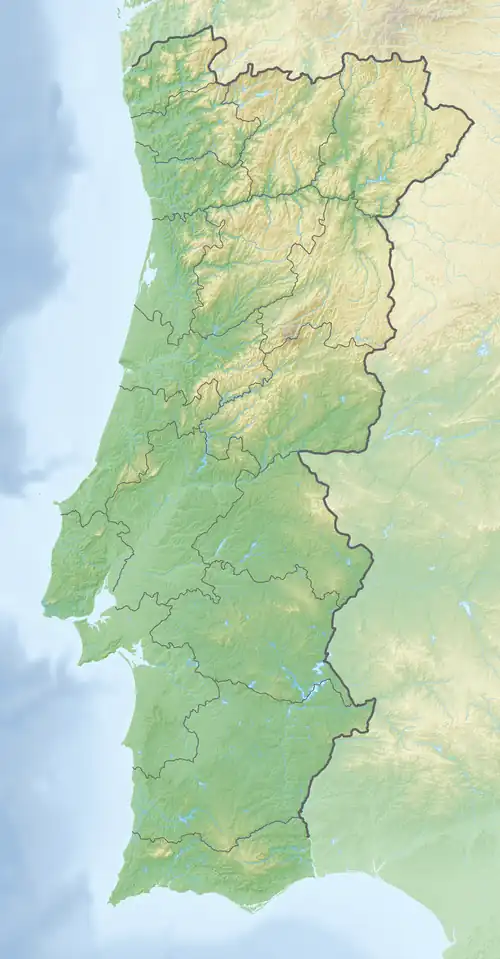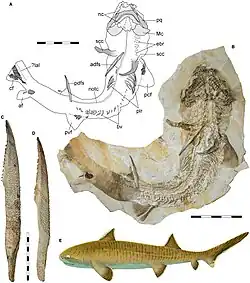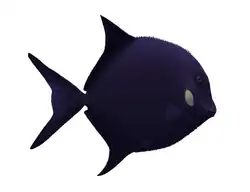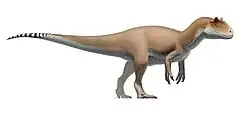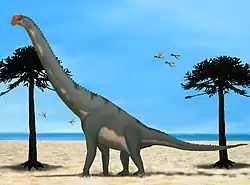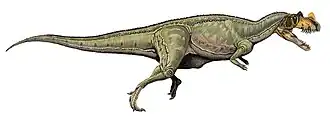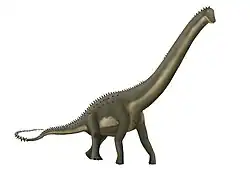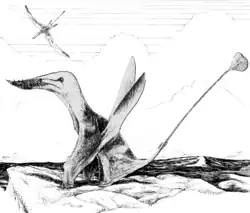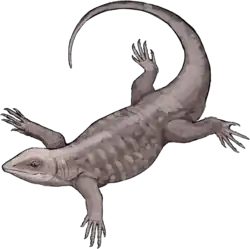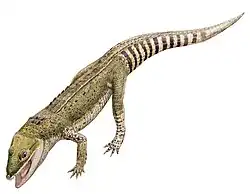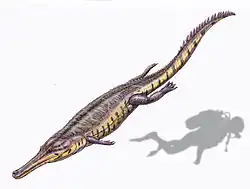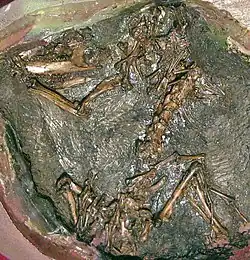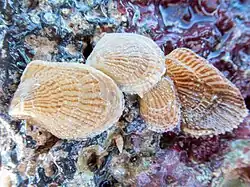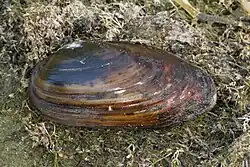The Alcobaça Formation , previously known as the Guimarota Formation and also known as the Consolação Unit,[ 1] is a geological formation in Portugal .[ 2] Kimmeridgian stage of the Late Jurassic . It is an important source of information on the diversity of Late Jurassic mammals.[ 3] [ 4]
Vertebrate paleofauna
Dinosaur eggs are geographically located in Lisbon District , Portugal.[ 5] Leiria District , Portugal.[ 6]
Chondrichthyes
Chondrichthyes of the Alcobaça Formation
Genus
Species
Location
Stratigraphic Position
Material
Notes
Images
Hybodus [ 7] Indeterminate
Guimarota
Isolated Teeth
Asteracanthus [ 7] A. biformatus
Guimarota
isolated teeth, fin-spine and a head-spine
Polyacrodus [ 7] Indeterminate
Guimarota
Isolated teeth and a fin-spine
Orectolobiformes [ 7] Indeterminate
Guimarota
One isolated tooth
Batomorphi [ 7] Indeterminate
Guimarota
Isolated teeth
Osteichthyes
Osteichthyes of the Alcobaça Formation
Genus
Species
Location
Stratigraphic Position
Material
Notes
Images
Macromesodon [ 7] Indeterminate
Guimarota
Isolated teeth
Proscinetes [ 7] Indeterminate
Guimarota
Isolated teeth and prearticulars
"Lepidotes " [ 7] Indeterminate
Guimarota
isolated lateral teeth, lower jaws, ganoid scales and isolated skull bones
Two species of different size can be distinguished from the fossil material[ 7]
Ionoscopidae[ 7]
Indeterminate
Guimarota
Isolated teeth
Macrosemiidae [ 7] Indeterminate
Guimarota
Isolated grasping tooth
Caturus ?[ 7] Indeterminate
Guimarota
Isolated Teeth and a partial skull
Pachycormidae [ 7] Indeterminate
Guimarota
Amphibians
Albanerpetontids are one of the most numerous faunal components of the Guimarota mine with around 9000 isolated remains, including parts of the skull and limbs. Remains of indeterminate salamanders and frogs are also present but far rarer.[ 7]
Choristoderes
Choristoderes of the Alcobaça Formation
Genus
Species
Location
Stratigraphic position
Material
Notes
Images
Cteniogenys Indeterminate
Guimarota
Ornithischians
Indeterminate euornithopod remains located in Lisbon District.[ 5] [ 5]
Ornithischians of the Alcobaça Formation
Genus
Species
District
Stratigraphic position
Abundance
Notes
Images
Dacentrurus [ 5] D. armatus [ 5] Lisboa [ 5]
Eousdryosaurus [ 8] E. nanohallucis
Lisboa[ 5]
Stegosaurus [ 9] S. cf. ungulatus
"...one tooth, five cervical vertebrae (including the axis), five dorsal vertebrae, cervical and dorsal ribs, three caudal vertebrae, chevrons, preacetabular process of the left ilium, right tibia, fibula, astragalus and [calcaneus], a cervical plate, and several fragments of plates."
Trimucrodon [ 5] T. cuneatus [ 5] Lisboa[ 5]
Later determined to be indeterminate ornithischian remains.[ 5]
Saurischians
Indeterminate sauropod remains located in Leiria and Lisboa.[ 10]
Pterosaurs
Turtles
Turtles of the Alcobaça Formation
Genus
Species
Location
Stratigraphic position
Material
Notes
Images
Peltochelys
P. duchastelli
Guimarota
Platychelys
Indeterminate
Guimarota
Pleurosternidae
Indeterminate
Guimarota
Lepidosauromorphs
Mammals
Mammals of the Alcobaça Formation
Genus
Species
Location
Stratigraphic position
Material
Notes
Images
Bathmochoffatia B. hapax
Guimarota
A paulchoffatiid multituberculate
Bernardodon B. sp, B. atlanticus
Porto Pinheiro
A pinheirodontid multituberculate
Drescheratherium D. acutum
Guimarota
A paurodontid dryolestidan
Dryolestes D. leirensis
Guimarota
A dryolestid dryolestidan
Ecprepaulax E. anomala
Porto Pinheiro
A pinheirodontid multituberculate
Guimarotodon G. leiriensis
Guimarota
A paulchoffatiid multituberculate
Guimarotodus
G. inflatus
Guimarota
A dryolestid dryolestidan
Haldanodon H. exspectatus
Guimarota
A docodont
Henkelodon H. naias, H. sp
Guimarota
A paulchoffatiid multituberculate
Henkelotherium H. guimarotae
Guimarota
A dryolestidan
Iberodon I. quadrituberculatus
Porto Pinheiro
A pinheirodontid multituberculate
Kielanodon K. hopsoni
Guimarota
A paulchoffatiid multituberculate
Krebsotherium
K. lusitanicum
Guimarota
A dryolestid dryolestidan
Kuehneodon K. guimarotensis, K. dietrichi, K. simpsoni, K. uniradiculatus, K. sp
Guimarota
A paulchoffatiid multituberculate
Laolestes L. andresi
Porto Pinheiro
A dryolestid dryolestidan
Meketibolodon M. robustus
Guimarota
A paulchoffatiid multituberculate
Meketichoffatia M. krausei, M. sp
Guimarota
A paulchoffatiid multituberculate
Nanolestes N. krusati
Porto Pinheiro
A cladotherian
N. drescherae
Guimarota
Paulchoffatia P. delgadoi
Guimarota
A paulchoffatiid multituberculate
Pinheirodon P. sp, P. vastus, P. pygmaeus
Porto Pinheiro
A pinheirodontid multituberculate
Plesiochoffatia P. thoas, P. peperethos
Guimarota
A paulchoffatiid multituberculate
Portopinheirodon
P. asymmetricus
Porto Pinheiro
A dryolestid dryolestidan
Priacodon Indeterminate
Porto Pinheiro
A triconodontid
Proalbionbaatar P. plagiocyrtus
Guimarota
A multituberculate of uncertain placement
Pseudobolodon P. dryas, P krebsi, P. oreas
Guimarota
A paulchoffatiid multituberculate
Renatodon
R. amalthea
Guimarota
A paulchoffatiid multituberculate
? Tinodon
Indeterminate
Porto Pinheiro
A tinodontid symmetrodont
Xenachoffatia X. oinopion
Guimarota
A paulchoffatiid multituberculate
Paulchoffatiidae
Indeterminate
Guimarota
4 distinct genera with 7 species
Pinheirodontidae
Indeterminate
Porto Pinheiro
Color key
Notes small text ; crossed out taxa are discredited.
Invertebrate Paleofauna
Ostracods
Ostracods of the Alcobaça Formation
Genus
Species
Location
Stratigraphic Position
Material
Notes
Images
Cetacella [ 7] C. armata
Cetacella is a typical component of Late Jurassic brackish water environments in Europe. Member of the Cypridacea [ 7]
C. inermis
C. striata
Theriosynoecum [ 7] T. wyomingense
Member of the Cytheracea
Bisulcocypris [ 7] B. pahasapensis
Member of the Cytheracea
Timiriasevia [ 7] T. guimarotensis
Member of the Cytheracea
Poisia [ 7] P. bicostata
Member of the Cytheracea
P. clivosa
Dicrorygima [ 7] D. reticulata
Member of the Cytheracea
Darwinula [ 7] D. leguminella
Member of the Darwinulacea
Mollusca
Bivalves
Bivalves of the Alcobaça Formation
Genus
Species
Location
Stratigraphic Position
Material
Notes
Images
Isognomon [ 7] I. rugosus
Guimarota
Dozens of well preserved shells sometimes making up entire stratigraphic layers
This genus is regarded as an indicator for brachyhaline water conditions and it was likely buried in its natural habitat[ 7]
"Unio
"U ." cf. alcobacensis
Guimarota
Dozens of well preserved shells with articulated valves
freshwater clam
Gastropods
Gastropods of the Alcobaça Formation
Genus
Species
Location
Stratigraphic Position
Material
Notes
Images
Teinostoma [ 7] Indeterminate
Guimarota
Shells
Boring traces of clionidid sponges on the shells of this taxon indicate a marine lifestyle[ 7]
Cryptaulax [ 7] Indeterminate
Guimarota
Shells
Melampoides [ 7] M. jurassicus
Guimarota
Shells
Boring traces of clionidid sponges on the shells of this taxon indicate a marine lifestyle, modern relatives like Melampus also venture onto land, which can also be expected from M. jurassicus[ 7]
See also
References
^ Mateus, O.; Dinis, J.; Cunha, P. P. (2017-09-28). "The Lourinhã Formation: the Upper Jurassic to lower most Cretaceous of the Lusitanian Basin, Portugal – landscapes where dinosaurs walked" . Ciências da Terra / Earth Sciences Journal . 19 (1): 75– 97. doi :10.21695/cterra/esj.v19i1.355 hdl :10316/79879 ISSN 2183-4431 . ^ Fürsich, Franz T.; Schneider, Simon; Werner, Winfried; Lopez-Mir, Berta; Pierce, Colm S. (2021-09-13). "Life at the continental–marine interface: palaeoenvironments and biota of the Alcobaça Formation (Late Jurassic, Central Portugal), with a formal definition of the unit appended" . Palaeobiodiversity and Palaeoenvironments . 102 (2): 265– 329. doi :10.1007/s12549-021-00496-x ISSN 1867-1608 . ^ "Guimarota" . Paleobiology Database . Retrieved 31 August 2018 .^ "Porto Pinheiro, Lourinha" . Paleobiology Database . Retrieved 31 August 2018 .^ a b c d e f g h i j k l m n o p q r s t u v w x y z aa "16.4 Distrito do Lisboa, Portugal; 1. Camadas de Alcobaça," in Weishampel, et al. (2004). Page 548.
^ a b c "16.1 Distrito do Leiria, Portugal; 3. Camadas de Alcobaça," in Weishampel, et al. (2004). Page 548.
^ a b c d e f g h i j k l m n o p q r s t u v w x y z aa ab ac ad ae af ag ah Palmer, Douglas (September 2001). "M ARTIN , T. & K REBS , B. (eds) 2000. Guimarota. A Jurassic Ecosystem . 155 pp. München: Verlag Dr. Friedrich Pfeil. Price DM 120.00 (hard covers). ISBN 3 931516 80 6" Geological Magazine . 138 (5): 619– 630. doi :10.1017/S0016756801316084 . ISSN 0016-7568 . ^ Fernando Escaso; Francisco Ortega; Pedro Dantas; Elisabete Malafaia; Bruno Silva; José M. Gasulla; Pedro Mocho; Iván Narváez; José L. Sanz (2014). "A new dryosaurid ornithopod (Dinosauria, Ornithischia) from the Late Jurassic of Portugal". Journal of Vertebrate Paleontology . 34 (5): 1102– 1112. Bibcode :2014JVPal..34.1102E . doi :10.1080/02724634.2014.849715 . S2CID 86780835 . ^ Escaso, Fernando; Ortega, Francisco; Dantas, Pedro; Malafaia, Elisabete; Pimentel, Nuno L.; Pereda-Suberbiola, Xabier; Sanz, José Luis; Kullberg, José Carlos; Kullberg, María Carla (2006-12-23). "New evidence of shared dinosaur across Upper Jurassic Proto-North Atlantic: Stegosaurus from Portugal". Naturwissenschaften . 94 (5): 367– 374. Bibcode :2007NW.....94..367E . doi :10.1007/s00114-006-0209-8 . PMID 17187254 . S2CID 10930309 . ^ "16.1 Distrito do Leiria, Portugal; 3. Camadas de Alcobaça," and "16.4 Distrito do Lisboa, Portugal; 1. Camadas de Alcobaça," in Weishampel, et al. (2004). Pages 548-549.
^ a b Burigo, André; Mateus, Octávio (January 2025). "Allosaurus europaeus (Theropoda: Allosauroidea) Revisited and Taxonomy of the Genus" . Diversity . 17 (1): 29. doi :10.3390/d17010029 ISSN 1424-2818 . ^ "Table 13.1," in Weishampel, et al. (2004). Page 265.
^ Guillaume, A. R. D.; Puértolas-Pascual, E.; Moreno-Azanza, M. (2025). "Revisiting the choristodere and stem-lepidosaur specimens of the Guimarota Beds (Kimmeridgian, Portugal): taxonomic implications" . Acta Palaeontologica Polonica . 70 (1): 77– 96. doi :10.4202/app.01202.2024 ^ Malafaia, E.; Ortega, F.; Escaso, F.; Dantas, P.; Pimentel, N.; Gasulla, J. M.; Ribeiro, B.; Barriga, F.; Sanz, J. L. (2010). "Vertebrate fauna at the Allosaurus fossil-site of Andrés (Upper Jurassic), Pombal, Portugal" . Journal of Iberian Geology . 36 (2): 193– 204. doi :10.5209/rev_JIGE.2010.v36.n2.7 ISSN 1698-6180 .
Bibliography
Weishampel, David B.; Dodson, Peter; Osmólska, Halszka (2004), The Dinosauria, 2nd edition 1– 880, ISBN 0-520-24209-2 , retrieved 2019-02-21 {{citation}}: CS1 maint: publisher location (link)
